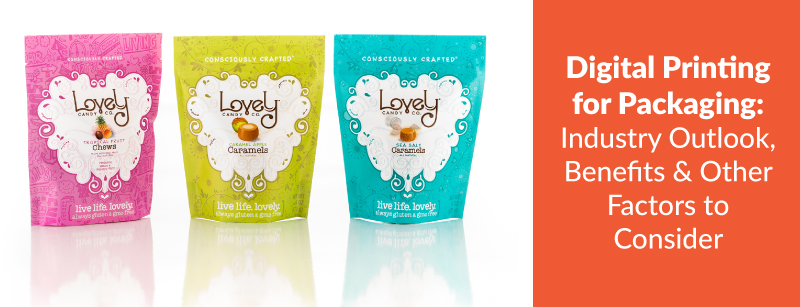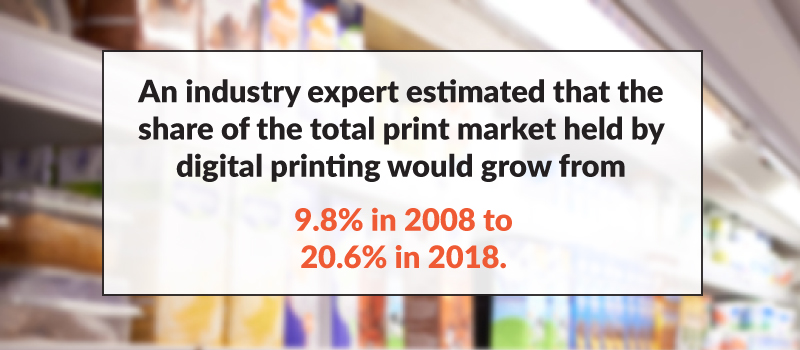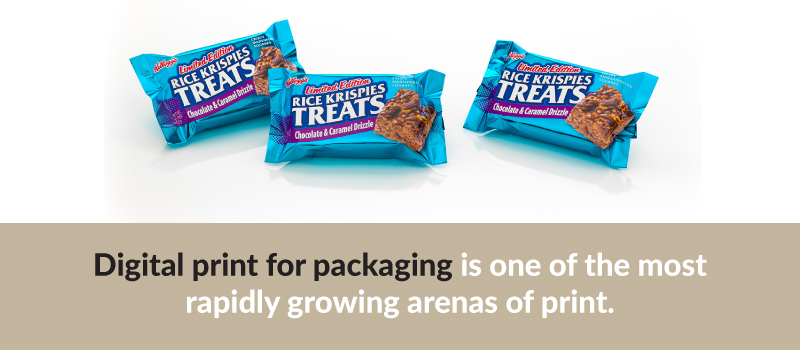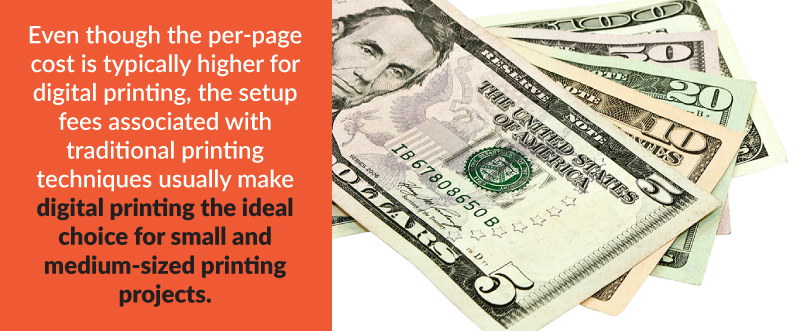Digital Printing for Packaging: Industry Outlook, Benefits & Other Factors to Consider
By: phase1Digital printing is a process in which a digital image is printed onto a substrate, such as paper. When you print a picture or a paper you’ve written at home using your personal computer and printer, you’re digital printing. When you print a summary report at work for your manager’s review, you’re also digital printing. While it’s obvious that digital printing is a common practice at home and in the workplace for many people, the term “digital printing” generally refers to professional print jobs that involve large-format inkjet or laser printers that are designed to handle high-volume, mass-production printing projects.
Compared to more traditional types of printing, such as lithography, flexography, gravure and letterpress, digital printing is fairly new and has risen in popularity since the early 1990s. In addition to being a newer kind of printing method, digital printing differs from more conventional printing techniques in some other fundamental ways, including the following:
- No printing plates: In offset printing, an image is burned onto a printing plate. The image is then transferred to a rubber blanket before it’s transferred once more onto a printing surface. Digital printing does not involve the use of printing plates, since the image is transferred directly onto the final substrate with no intermediate steps.
- Less lead time: Since digital printing doesn’t involve printing plates that must be crafted before a print job can be started, digital printing jobs typically require less lead time and have a shorter turnaround time as a result.
- No permeation: In traditional printing, the ink that’s used to reproduce an image permeates the surface it’s used to print on. The ink used in digital printing doesn’t permeate a substrate. Instead, the ink forms a thin layer on the surface of the substrate and is dried to adhere to the print material.
Digital Printing: Industry Outlook
Digital printing differs from offset printing when it comes to the future and price, as well. In a market study released in 2013, an industry expert by the name of Smithers Pira estimated that the share of the total print market held by digital printing would grow from 9.8 percent in 2008 to 20.6 percent in 2018.
The report further suggested that the amount of all offset prints would decrease by 10.2 percent between 2008 and 2018, while the total number of digital prints would increase by 68.1 percent during the same time period. Smithers Pira also expects the price per 1,000 A4 offset prints to fall 11.1 percent, from $11.43 in 2008 to $10.16 in 2018, while the price per 1,000 digital prints is expected to rise from $92.48 in 2008 to $119.53 a decade later.
Many adjectives can be used to describe the outlook for the digital printing industry. “Explosive” is one that immediately comes to mind when you look at the numbers forecast for the industry as a whole. In his recent market study, “The Future of Digital Printing to 2024,” Pira reports that the 2013 digital print market was worth $120.9 billion in 2012 dollars. Pira predicts that the total value of the digital print market will reach 225 percent of its 2013 value by 2024.
According to Smithers Pira, “The maturing of Big Data with technology able to identify potentially valuable customers is a very powerful tool, and digital print will be used as a communication channel for this output. Digital print will also exploit many new opportunities for high-value short runs and move increasingly into labels and packaging.”
Pira continues: “In terms of future forecasts, the report states that over the next ten years or so, the most dynamic area for change will be in the fields of packaging. Cartons, rigids, flexibles, metal and corrugated are sectors that will take up digital production methods. Future growth predictions for printed packaging are all positive with increases in volume and value, with no substitution for electronic versions.”
While the digital printing industry as a whole is anticipating tremendous growth in the upcoming years, certain segments of the industry may grow at a more rapid pace than others do. In another market report entitled “The Future of Digital Print for Packaging to 2020,” Smithers Pira claimed that “digital print for packaging is one of the most rapidly growing arenas of print.” Smithers Pira estimated the value of this market segment to be $10.5 billion in 2015 and forecast it to increase to $19.8 billion in 2020.
Although electrophotography is currently the primary form of digital printing for packaging, Smithers Pira predicts that inkjet will overtake electrophotography in digital package printing by 2018. This is primarily because inkjet is better suited for use on a wider selection of substrates. Packaging labels are responsible for 93.5 percent of the printed volume in this industry segment, but Pira expects corrugated, cartons and flexibles to develop into significant niches prior to 2020.
In addition to becoming the dominant digital printing method for packaging in the next few years, inkjet is likely to surpass electrophotography in the digital printing industry as a whole by 2024. According to a report prepared by Pira, inkjet will be used in 53 percent of all digital print volume and it will be responsible for 56 percent of the industry’s total value by 2024.
When you think of digital printing and how it’s commonly used today, your mind is probably instantly drawn to the graphics and packaging sectors, but this may soon change. As the industry continues to grow, new technology is making it possible for digital printing to be used for new applications, including the following:
- Textiles
- Ceramic tiles
- Flat glass
- Round glass
- Laminates
- Architectural design
- Automotive products
- Electronic products
- Print-on-demand (e.g. personalized children’s books with your child’s name used in them)
- Photovoltaic products
- Bio-medical goods
The Benefits of Digital Printing
While offset printing is still used for the majority of print jobs today, digital printing offers some inherent benefits that more traditional printing techniques don’t have. These benefits include the following:
- No setup fees: With conventional offset printing, a printing plate has to be made and the printing press has to be adjusted to accommodate every individual project. Digital printing doesn’t require printing plates or a mechanical adjustment, so you don’t need to pay a setup fee for a digital printing project the way you would for an offset printing job.
- Affordable prototyping: Digital prototyping is more affordable than producing prototypes using offset printing, since you don’t need a printing plate and you don’t need to adjust a printing machine to print packaging mockups. If you want to experiment with different creative product packaging designs to see which one resonates best with your clients, you’ll want to do so using digital printing to keep your costs down.
- Sustainability: Digital prototyping and printing is more environmentally friendly than traditional printing is. Whether you use digital printing to create custom product packaging, produce business cards or something else entirely, no fumes are released into the environment during the printing process, and you don’t need to use film or photo chemicals to complete your project.
- Cost-effectiveness: In general, your order has to be of a certain size in order to use the services of a professional offset printer because of the setup that’s necessary to perform this kind of printing. This means you may have to order 1,000 units of something, even though you only need half that amount.
Since no setup is required for digital printing, this printing method is flexible enough to accommodate orders of all sizes, including orders of just one unit. Since you’ll only get the number of units you order, digital printing can help you keep your overhead low, because you won’t have to store excess units of your printed materials in your inventory, where they may become obsolete before you even have a chance to use them.
Even though the per-page cost is typically higher for digital printing, the setup fees associated with traditional printing techniques usually make digital printing the ideal choice for small- and medium-sized printing projects. For example, if a traditional printer charges a setup fee of $100 and $0.10 per page, while a digital printer charges $.25 per unit and you want 50 printed pages, the setup fee would make working with the offset printer cost-prohibitive. Using the digital printer, you would spend $12.50 for your print job. If you gave your project to the conventional printer instead, you would have to pay $105.00 for your completed project.
- Greater consistency: Because you don’t have to worry about balancing the ink and water that are necessary in traditional printing, there will be significantly fewer variations in your finished products when you use digital printing.
- Variable data capabilities: In order to create different versions of the same thing using offset printing, a new plate and machine setup is required for each version you want printed, even when only minor changes distinguish one end product from another. Digital printing has variable data capabilities, which makes it possible for text or graphics to be changed on every piece without stopping your print job at any point. This makes digital printing ideal for things such as direct mail campaigns, because you can put a different name and address on every letter and envelope included in your batch order without slowing down the printing process.
- Customizable: Given its variable data abilities and the ability to change prototypes easily without having to create a new printing plate, digital printing is perfect for customizable printing projects, including custom product packaging. Coca-Cola took advantage of digital printing’s versatility when it used this printing method to randomly print names sequentially on more than one billion Coca-Cola products for its “Share a Coke” campaign. The campaign was so successful that it not only increased bankable sales, but also increased valuable social media engagement with the Coca-Cola brand, as well.
- Greater opportunity for promotions: Depending on your industry, you may be interested in running personalized promotions for certain products. Digital printing has the flexibility required for you to do so.
Heineken recognized this benefit of digital printing, and the beer maker promotes its products by giving Europeans the chance to mail-order six packs of Heineken beer that have their own personal designs on them. Seeing the versatility that digital printing provides, US-based soda maker Jones Soda started encouraging consumers to send in label designs. Jones Soda uses chosen submissions to label all of its goods to give a personal touch to its beverages.
Why Work with Phase 1 Prototypes for Your Digital Printing Needs?
Founded in 2006, Phase 1 Prototypes has been working to help clients give life to their creative visions for a decade. We’re recognized as a leading packaging mock-up and prototype studio because of our expert packaging design services, technical innovation and unrivaled customer service. Our product packaging designs can be seen in many industries, including the food and beverage, spirits, housewares and sporting equipment industries.
At Phase 1 Prototypes, we believe there isn’t anything we can’t do! That’s one of the reasons we’re considered an industry innovator. In fact, we’re so committed to making our clients’ visions a reality that we’ve created our own proprietary substrates on multiple occasions to make their ideas work successfully. We have the technical ability to develop creative product packaging designs that use a wide variety of styles, textures and colors to give your prototype the unique characteristics it needs to stand out from the competition and strike a chord with consumers.
Our digital printers print white, clear and four-color process inks on a wide variety of materials and package types. When working with clear substrates, this is necessary to prevent your images from appearing transparent. Using white ink on clear substrates ensures your images will come alive with vibrant color that will catch a consumer’s eye. We can also add features to your packaging, such as raised edges, to help your products stand out even more.
We have a proprietary process that enables us to print packaging prototypes with spot varnish effects, as well — something that was very expensive and time-consuming to do before digital printing studios like ours were established. Our advanced equipment also enables us to add embossing to your packaging, which gives you the chance to experiment with raised type and other design ideas. We can digitally print gold foil samples for your products, too, which allows us to try various metallic effects and use different materials when we’re developing your prototype. We also specialize in printing mockups using metallic ink in runs ranging from one unit to 500 or more.
Whether you’re in the brainstorming phase or you already know what you want your packaging to look like, we’re here to help make your vision a tangible reality. From boxes and cardboard displays to custom point-of-purchase displays and much more, there isn’t anything we can’t do. And there isn’t anything we won’t do to ensure you’re more than satisfied with your digital prototype.
If you’d like to learn more about the digital printing and design services we provide, give us a call or stop by our convenient location in Dallas, TX today. We offer quick turnaround times for people who need to have something done quickly and, if necessary, we can have your project done the same day.
If you’ve dreamed it, we can make it a reality! Contact Phase 1 Prototypes to learn more today.






Leave a Reply